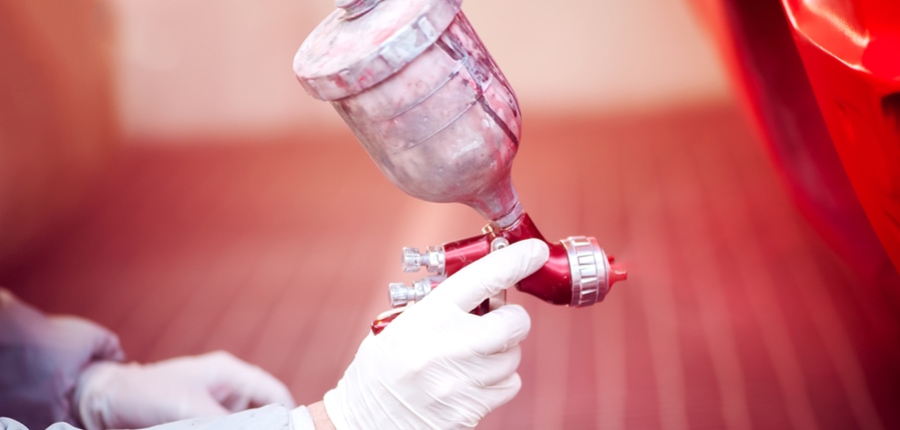Decades ago, cars were painted by hand and it took weeks for it to dry. This is because the paint that was being used at the time dried via solvent evaporation and took much longer.
Nowadays, manufacturing factories have replaced human hands with robotic ones which sped up the process tenfold. Water-based enamel paints have also replaced lacquer paint – increasing the drying speed.
You may be wondering how much it costs to repaint a car. Keep reading to arm yourself with all the knowledge on the subject including popular body shops, pricing, paint types, and their subsequent pricing.
What Are the Costs Involved with Car Painting?
Car respray costs generally run from $300 to $900 for a standard-quality job which involves the use of inexpensive paint.
For example, Earl Schreib shops will usually charge around $399 for a complete car repaint. Maaco’s automobile paint job estimate usually comes out at around $300 but can range up to $1,500 for high-quality jobs.
These two body shops by far have the lowest rates for car painting, so look them up if you’re on a tight budget and your vehicle needs a quick coat of paint.
Be aware, though, that the quality of a paint job will directly determine how long the paint lasts, so you’ll find that slightly more expensive bodywork which involves multiple stages and might take up to a week will retain its brightness and color for longer.
Toyota will charge between $300 and $600 for a professional light coating of paint that will breathe some fresh life into your vehicle’s metal shell. For a complete paint overhaul, you’re more likely to see something within the $1,000 – $2,000 range.
If you’re from the state of California, paint jobs for cars at San Francisco Auto Repair and Auto Body Shop start at $1,000.
It’s important to understand that when it comes to painting jobs, there’s usually much more involved than just painting. The vehicle needs to properly prepped before the work actually starts. Surface preparation begins with treatment for chips, scratches, and excessive peeling.
If any dents or other forms of damage exist, they need to be fixed beforehand, and the mechanic will add the charge to the bill. The body of the car is usually sanded down and any rust removed before painting commences.
Although Maaco and Earl Schreib feature low prices intended for the masses, other body shops can charge from $1,000 – $3,500 for a complete coat of standard paint, depending on the factors mentioned above. In order to cut down on the costs involved, a lot of people do the prep work on the car by themselves at home.
Once the car is sanded, old paint stripped, and rust removed, they bring it in ONLY to be painted, which saves quite a bit of cash. If you’d like to try this and potentially save hundreds of dollars, we’ve prepared a DIY guide at the end of this article.
For showroom-quality car painting, the job can take up to a month and cost as much as $20,000. You get what you pay for, so it all comes down to quality vs. price.
When asking for quotations, keep an eye out for oddly low pricing – many unethical and dishonest auto shops will not remove the trim and simply mask it off. They may skip areas of the car that aren’t visible, and you may spot running (paint build-up near the bottom which indicates overspray).
Bubbles in the paint, uneven surfaces, and small visible flecks of dirt are all potential issues associated with low-cost auto body providers.
The size and type of car will play a role in determining the overall and final painting cost. It will cost around $750 to paint an entire Toyota Corolla (price includes base and clearcoat, no prep work). A Ford F-150 paint job using high-quality paint is estimated at around $2,500, which includes prep work.
Professional painters will usually use about 3 quarts of paint for a mid-sized car but may need a little more if they’re covering the trunk, door jambs, and under the hood. Larger cars, such as SUVs, will need about 6-7 quarts of paint, especially if they’re being spray-painted.
Different types of paint used include enamel, basecoat paint (for two-tone painting), clear coat paint, waterborne enamels, and urethane paints, among others.
If you don’t want to paint, having your car wrapped in a cheaper expense is a viable alternative.

Reasons Why Car Painting Is Beneficial
Oxidation can cause paint damage along with peeling and scratches. Normal wear and tear can run a car’s paint down and it can fade away over time. Re-painting a car under these conditions is a great way to breathe fresh life into it and restore the look to its former glory.
Besides that, you might simply want to change the color of your car just for kicks or maybe to try something new. The entire car can be completely repainted or perhaps a small section only.
Custom body shops can create patterns and styles other than a typical plain one-tone coat. In the event that you’re planning to resell your automobile, this becomes a key selling point. The resale value on the car will be much higher with a decent paint job.
If you’re into auto restoration, you’ll need a beautiful paint job to help keep that 1930s roadster looking sleek and in prime condition.
Keep your car paint in good shape though, and you won’t have to repaint as often! Invest in a good coat of paint and it’ll last for a very long time.
How Long Does A New Paint Job Last?

Well, most car painting shops offer different levels of service. As you’ve found out, some sell cheaper painting packages that only cost a couple of hundred dollars, while others cost more than a thousand. Depending on the quality of the work, a paint job could last for months or up to a decade.
This is the reason why it’s important to properly assess the company that you put your trust in to handle your car.
A poor-quality paint job may look fine at first but will begin to exhibit subtle issues as the days go by. Air bubbles and small pieces of dirt and debris may have gotten trapped and were covered over with the paint.
Once it dries, you’ll be able to see the outline of whatever caused the problem. Air bubbles will burst out and cause the paint to either warp or break out with indented holes.
Paint can fade out in appearance due to mildew fungus that enters the paint’s microscopic pores and begins to grow. It takes quite a long time for them to make a dramatic effect on the appearance of the paint, but after a year or so, old paint will begin to have that faded look due to an abundance of these fungi.
That’s what wax is for – to seal the tiny pores on the surface of the paint.
If your paint is already faded out, you can revitalize it by wiping it down with bleach and then rinsing it with water. This kills most of the mildew and restores a bright and cheery sheen.

